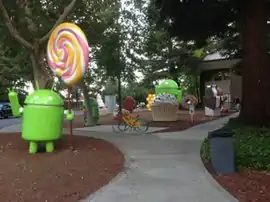| Android lawn statues | |
|---|---|
 The Android lawn statues in 2015 | |
| Medium | Sculpture |
| Location | Mountain View, California |
| Charleston Rd & Huff Ave | |
| Owner | |
The Android lawn statues are a series of large foam statues near the Googleplex (Google's headquarters) in Mountain View, California, currently located at Charleston Rd & Huff Ave. They are based on the code names for versions of Google's Android mobile operating system, which were named after desserts and sweet treats. Google used to commission a statue for each new Android version, a tradition that ended in 2019 after the release of Android 10. Starting with Android 11, the statues are created as virtual 3D models.[1]
These statues were originally located in front of Building 44, where the Android development team had its offices, before being moved to their present location a few blocks away next to the Google Visitor Center Beta. The area is open to Google employees and their guests, and visitors are encouraged to take photos.
Up to 2013's KitKat, all the sculptures were made by the company Themendous, previously known as Custom Creations.[2][3]
Background
Google's Android is the fastest selling mobile operating system as of late 2010[4] and was developed as a partnership with the Open Handset Alliance, with version 1.0 being released on September 23, 2008.[5] The first publicly codenamed version of Android was "Cupcake" which was released on April 27, 2009.[6] Versions 1.0 and 1.1 did not have codenames following this scheme. There was initially a plan to use famous robot names in alphabetical order, and some early interim revisions have been tagged "Astro Boy" and "Bender". Eventually, this plan was discontinued, and version 1.0 did not have a codename, but version 1.1 got the internal codename "Petit Four", which launched the custom of naming Android releases after desserts. When codenames became public with version 1.5, they started to follow alphabetical order, beginning with "C" (apparently since the two previous public releases have been 'skipped' in this scheme). Since then, further releases of Android were named after desserts or sweet treats, with names being chosen in alphabetical order, although sometimes the same name was applied to multiple versions.[7] Google stopped using dessert names as marketing names in 2019 with Android 10,[8] however, they continued to be used internally and were even referenced on 11 and 12's statues ("Red Velvet Cake" for 11, and "Snow Cone" for 12).[9][10] The statues were temporarily removed in early 2022 for relocation and repair.[11]
A few days before each named operating system was unveiled, Google used to unveil a lawn statue representing that version's codename. The statues were on the lawn in front of Building 44, where the Android development team worked[12] until August 2014.
Google stopped making physical statues after Android 10, which also was the first release that no longer used dessert theme names externally.[1][13] Starting from Android 11, Google continued the tradition by releasing "statues" as 3D objects viewable online.[13] The statue for Android 13, codenamed "Tiramisu" internally, was made in both physical and virtual formats.[14]
Statues

The green Android was joined early on by Alex, a dog of similar colour and design. It was actually a toy chair, Puppy by Eero Aarnio. This statue was stolen in 2009.[15]
A similar incident happened in 2012. Due to the summer heat, the head of the Jelly Bean statue popped off, and one of the jelly beans inside was stolen. This prompted Android engineer Dan Morrill to post on Google+: "Jelly Bean is so ridiculously hot that the JB statue overheated, and his head partially melted and popped off. And then we think somebody stole one of the jelly beans. People: please don't steal our jelly beans."[16] The statue has since been repaired.
In 2017, for the Android Oreo statue, Google ordered two different statues, with one of them featuring a single Oreo and a boxy design and the other (made by Themendous) with multiple Oreos and a more roundish shape.[17]
The statues in the order of installation are:
| Statue | Android version | Codename | Physical/Virtual |
|---|---|---|---|
| A green Android robot | Represents the operating system in general, and Android 1.0. | Physical | |
| A cupcake | 1.5 | Cupcake | Physical |
| A donut | 1.6 | Donut | Physical |
| An éclair drizzled with chocolate syrup[18] | 2.0, 2.1 | Eclair | Physical |
| A dish of frozen yogurt[19] | 2.2 | Froyo | Physical |
| A Nexus One | First Google phone and 2.2 "Froyo" flagship device | Physical | |
| An orange pair of headphones | Google Play Music | Physical | |
| A gingerbread man[20] | 2.3 | Gingerbread | Physical |
| A piece of honeycomb with a bee and the Android robot[2] | 3.0, 3.1, 3.2 | Honeycomb | Physical |
| An ice cream sandwich in the shape of the Android robot[21] | 4.0 | Ice Cream Sandwich | Physical |
| A jar in the shape of the Android robot filled with jelly beans[22] | 4.1, 4.2, 4.3 | Jelly Bean | Physical |
| A KitKat bar in the shape of the Android robot[3] | 4.4 | KitKat | Physical |
| An Android robot holding an oversized swirl lollipop[23] | 5.0, 5.1 | Lollipop | Physical |
| An Android robot holding an oversized marshmallow[24] | 6.0 | Marshmallow | Physical |
| An Android robot standing on nougat bars[25] | 7.0, 7.1 | Nougat | Physical |
| An Android superhero robot with an Oreo cookie on it (two statues were made)[17] | 8.0, 8.1 | Oreo | Physical |
| An Android robot with a cherry pie with a slice cut out of it[26] | 9.0 | Pie | Physical |
| A giant signed "10" statue with the Android logo on the digit "0"[27] | 10.0 | Quince Tart | Physical |
| A giant "11" statue with the Android logo between the numbers and a recipe for red velvet cake on the side[28] | 11.0 | Red Velvet Cake | Virtual |
| A giant "12" statue with the Android logo on the digit "1", a cone on the digit "2", and snow pile on the bottom[29] | 12.0, 12.1 | Snow Cone | Virtual |
| A giant sideways "13" statue with the digit "1" as the handle containing "thirteen" in 13 languages and the digit "3" as the seats.[30][14] | 13.0 | Tiramisu | Both |
| A statue of Bugdroid’s full body in a jersey with the number "14", doing a handstand on an upside-down cake.[31] | 14.0 | Upside Down Cake | Both |
See also
References
- 1 2 "Google dumped a snow cone on its new 3D Android 12 statue, and that's pretty much how we feel about it too". Android Police. 2021-10-19. Retrieved 2021-11-07.
- 1 2 Graham, Fiona (2011-03-02). "Look on Google's Android Honeycomb statue, ye mighty, and despair!". CNET. Retrieved 2021-11-07.
- 1 2 King, Bertel Jr. (September 4, 2013). "Themendous Is The Company That Makes Google's Android Statues, Here's How They Made The Latest 'KitKat' One". Android Police. Retrieved January 4, 2017.
- ↑ Savov, Vlad (January 31, 2011). "Canalys: Android overtakes Symbian as world's best-selling smartphone platform in Q4 2010". Engadget. Retrieved 10 November 2011.
- ↑ Morrill, Dan (September 23, 2008). "Announcing the Android 1.0 SDK, release 1". Android Developers Blog. Retrieved 27 October 2011.
- ↑ Ducrohet, Xavier (April 27, 2009). "Android 1.5 is here!". Android Developers Blog. Retrieved 27 October 2011.
- ↑ Amadeo, Ron (17 September 2012). "A History of Pre-Cupcake Android Codenames". Android Police. Archived from the original on 25 August 2013. Retrieved 7 October 2013.
- ↑ "Android's iconic dessert names are going away, starting with Android 10". Android Police. 2019-08-22. Retrieved 2021-11-07.
- ↑ "Even Android 11 is cake". 23 July 2020.
- ↑ "Android 12's dessert name is confirmed to be Snow Cone". 4 October 2021.
- ↑ "The Android lawn statues have disappeared from Google HQ, but here's why". 22 March 2022.
- ↑ Kowitt, Beth (June 16, 2011). "100 million Android fans can't be wrong". Fortune. Archived from the original on 26 October 2011. Retrieved 27 October 2011.
- 1 2 Schoon, Ben (2021-10-19). "How to check out Google's Android 12 'Snow Cone' 3D statue". 9to5Google. Retrieved 2021-11-07.
- 1 2 "Android 13's AR and real-life statues are a real 'Swingin Party'". 16 August 2022.
- ↑ Martin, Michael (October 1, 2009). "Android Dog Statue Of GooglePlex Stolen". Search Newz. Archived from the original on 4 November 2011. Retrieved 27 October 2011.
- ↑ "Dan Morrill asks people not to steal Jelly Beans on Google+". July 2, 2012. Archived from the original on 2012-10-19. Retrieved October 15, 2012.
- 1 2 "One of these Android Oreo statues is not like the other". Android Central. 2017-08-21. Retrieved 2017-08-22.
- ↑ Kincaid, Jason (15 October 2009). "Google Unwraps Android's Giant Eclair". TechCrunch. Retrieved 18 December 2021.
- ↑ "TechCrunch Spies A Wrapped Froyo Sculpture At The Googleplex. Forget That - Here Is The Unwrapped Sculpture Caught On Camera In Its Full Glory". Android Police. 13 May 2010. Retrieved 18 December 2021.
- ↑ Russakovskii, Artem (22 October 2010). "Giant Gingerbread Statue Arrives At Googleplex". Android Police. Retrieved 18 December 2021.
- ↑ "Calling All Ice Cream Sandwich Lovers". YouTube. Android Developers. Retrieved 18 December 2021.
- ↑ Westaway, Luke (June 27, 2012). "Android Jelly Bean confirmed by new Google statue". CNET UK. Archived from the original on June 29, 2012. Retrieved February 13, 2013.
- ↑ Seifert, Dan (15 October 2014). "Android 5.0 Lollipop gets its statue". The Verge. Retrieved 2015-08-11.
- ↑ F, Alan. "Google: Android M is Marshmallow as statue is rolled out on the lawn; new build starts with Android 6.0". Phone Arena. Retrieved 19 December 2021.
- ↑ Whitwam, Ryan (June 30, 2016). "Android N's official name: Android Nougat". Geek.com. Ziff Davis. Archived from the original on July 1, 2016. Retrieved July 1, 2016.
- ↑ Friedman, Alan. "Some of Android 9.0 Pie is about using AI to adjust your phone to just the way you want it". Phone Arena. Retrieved 18 December 2021.
- ↑ Friedman, Alan. "Google keeps up with one tradition related to the new Android build". Phone Arena. Retrieved 18 December 2021.
- ↑ "Android 11 AR Statue Experience".
- ↑ "Android 12 AR Statue Experience".
- ↑ "Android 13 AR Statue Experience".
- ↑ "Google's Android 14 statue will make you turn upside down". Android Police. 2023-10-06. Retrieved 2023-10-08.